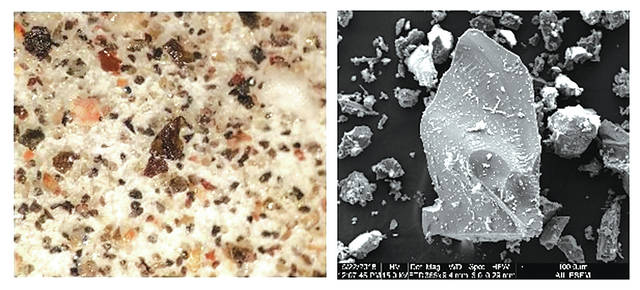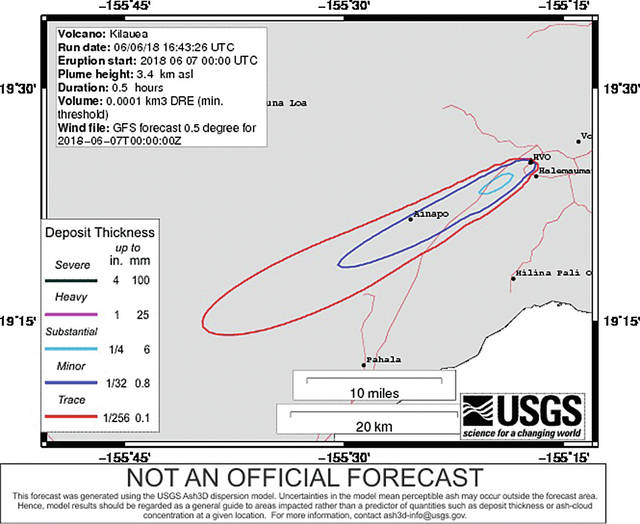Volcano Watch: How to protect yourself from volcanic ash produced by Halema‘uma‘u explosions

Photos courtesy of PAVEL IZBEKOV, UAF-GI AVO Volcanic ash from an eruption at the summit of Kilauea on May 17. LEFT: This low magnification photo shows ash particles ranging from a few microns to a couple of millimeters in diameter. RIGHT: A high-powered scanning electron microscope reveals great detail on this basalt ash shard.

Graphic showing where and how much ashfall is expected based on forecast winds and best estimate information about the size and duration of a Wednesday explosion from Halema‘uma‘u. Forecast models for an explosion at any time can be found on the HVO website at https://volcanoes.usgs.gov/observatories/hvo/ash_information.html.
Small explosions that produce ashfall from Kilauea Volcano’s summit are not new. However, the mechanism, vigor, plume heights and extent of ash fallout from the current explosive activity within Halema‘uma‘u are.
Small explosions that produce ashfall from Kilauea Volcano’s summit are not new. However, the mechanism, vigor, plume heights and extent of ash fallout from the current explosive activity within Halema‘uma‘u are.
Previous ash emissions from Kilauea’s summit have been caused by rocks falling from the steep vent walls. These rockfalls triggered numerous small gas-driven explosions that blasted molten lava and pieces of older rock — with sizes ranging from volcanic ash up to large rocks — onto the rim of Halema‘uma‘u and the adjacent caldera floor.
ADVERTISING
In early May 2018, in response to changes on Kilauea’s East Rift Zone, the summit lava lake dropped hundreds of yards and the magma feeding the lava lake dropped below the water table, allowing groundwater to enter the system. This began a series of more vigorous steam-driven explosions that produced more significant ash clouds from the summit.
As the magma reservoir lowers and drains out (erupts) at the lower East Rift Zone, the summit area is slowly subsiding and slumping inward, which is triggering additional gas-driven explosions. This has heralded a new type of eruption from Kilauea’s summit. Ash clouds have risen as high as 30,000 feet above sea level, but have more commonly been 5,000 to 10,000 feet above sea level.
What is ash?
Ash is tiny pieces of rock formed during explosions that are carried in an ash cloud downwind where they fall to the ground. The grains of ash are just like fine sand, but they can have an acidic outer layer from volcanic gases in the cloud. Rainfall can rinse this acid from the ash.
Where will ash clouds go, and how much ash will fall?
Where ash goes is largely determined by wind direction. Most ash clouds at Kilauea have reached less than 15,000 feet above sea level; therefore, they have been following trade wind patterns toward the southwest, mainly over the Ka‘u District and Highway 11, southwest of the community of Volcano.
Ash falling from the cloud and onto the ground results in hazy conditions and a dusting of ash on exposed surfaces. The amount of ash produced depends on the size and duration of the explosion. Based on Kilauea’s explosions to date, only trace amounts of ash (less than 1/32nd of an inch) are expected at any one time. This can change if the eruptions increase in size or duration. Ash layers can accumulate over time, if they are not washed away by rain.
What are the hazards of ash clouds and ashfall?
Ash clouds are hazardous to aircraft, which is why the NOAA National Weather Service is working closely with the USGS Hawaiian Volcano Observatory to track ash clouds and issue aviation warnings.
Ash in the quantities we expect should mostly be a nuisance, but it can be harmful to humans, animals and the environment. Health effects include irritation to the eyes, nose, throat and skin. People with asthma or other breathing conditions are particularly susceptible to respiratory effects. Ash can impact drinking water quality and catchment systems by contaminating the water supply. Ash is abrasive and corrosive and can be harmful to animals and damaging to plants and crops.
How can I protect myself before, during, and after ashfall?
Before
• Become familiar with wind conditions that might bring ash to your area.
• Check out the USGS ashfall forecast model, showing where and how much ashfall is expected (https://volcanoes.usgs.gov/observatories/hvo/ash_information.html).
• Cover water tanks, close doors and windows.
• Bookmark key monitoring and information websites (https://vog.ivhhn.org/ and https://volcanoes.usgs.gov/volcanic_ash/).
During
• Disconnect gutters feeding into drinking water tanks (https://vog.ivhhn.org/catchment-systems).
• Shelter in place (stay indoors) and limit strenuous outdoor activities. Leave the area if necessary.
• Assume that respiratory symptoms could get worse and keep medications handy for asthmatics.
• Consider using an indoor air cleaner or air conditioner, and prevent tracking ash into the house.
• Use an N95 mask to reduce exposure to ash if you need to be outside and especially during clean up.
After
• Drink plenty of liquids and treat congestion or irritation.
• Clean and reconnect gutters to tanks.
• Hose off ash from high-traffic areas (walkways, etc.).
• See a physician if symptoms don’t go away after exposure.
• If ash is resuspended by human activities, such as cleaning or driving, wear a dust mask during those activities.
U.S. Geological Survey scientists are monitoring Kilauea Volcano’s summit activity around the clock and keeping Hawaii County Civil Defense apprised of any changes. Residents are encouraged to heed all safety messages.
Volcano activity updates
On Kilauea Volcano’s East Rift Zone, lava continues to erupt from an active fissure system. As of Thursday, fissure 8 lava fountains were feeding a lava channel flowing east toward the ocean entry in the former Kapoho Bay area. Residents in the lower Puna District should remain informed and heed Hawaii County Civil Defense closures, warnings and messages (http://www.hawaiicounty.gov/active-alerts). At Kilauea’s summit, ash emissions were diminished, possibly reflecting the accumulation of rubble at the base of the growing summit eruptive vent. Earthquake activity remains high due to continued summit deflation. Additional explosive events that could produce minor amounts of ashfall downwind are possible at any time. Volcanic gas emissions at the summit remain high.
Mauna Loa is not erupting. Rates of deformation and seismicity have not changed significantly over the past week. The number of monthly and weekly earthquakes recorded beneath the volcano has decreased to near background levels. Thirty-one earthquakes were reported felt in Hawaii during the past week.
Visit HVO’s website (https://volcanoes.usgs.gov/hvo) for past Volcano Watch articles, Kilauea daily eruption updates and more. Call for summary updates at 808-967-8862 (Kilauea) or 808-967-8866 (Mauna Loa).
Volcano Watch (https://volcanoes.usgs.gov/hvo/hvo_volcano_watch.html) is a weekly article and activity update written by U.S. Geological Survey Hawaiian Volcano Observatory scientists and affiliates.


